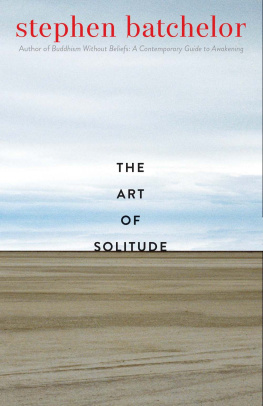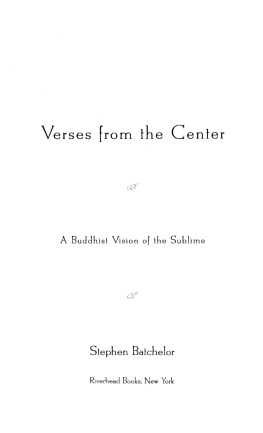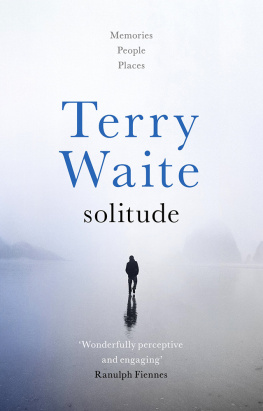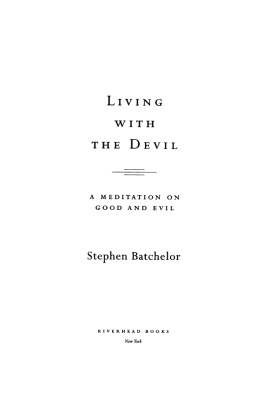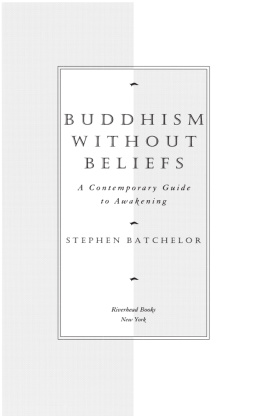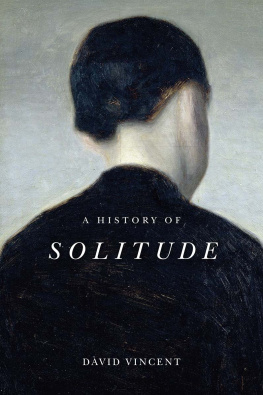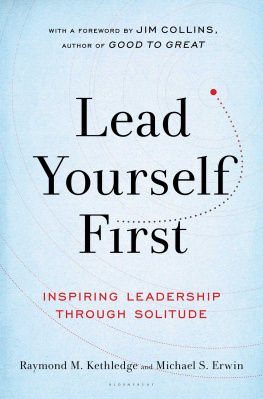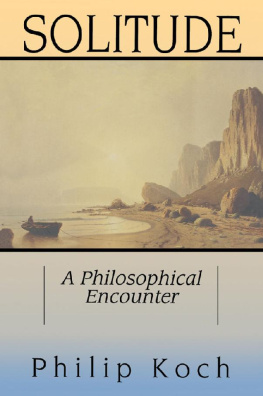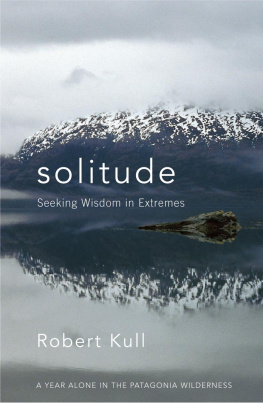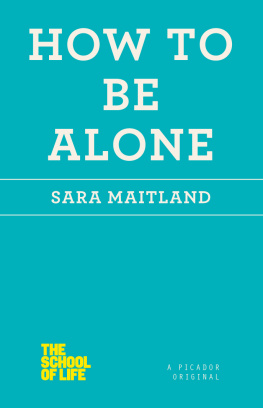the art of solitude
yale
university
press
new haven
and
london

Published with assistance from the foundation established in memory of Philip Hamilton McMillan of the Class of 1894, Yale College.
Copyright 2020 by Stephen Batchelor. All rights reserved. This book may not be reproduced, in whole or in part, including illustrations, in any form (beyond that copying permitted by Sections 107 and 108 of the U.S. Copyright Law and except by reviewers for the public press), without written permission from the publishers.
Yale University Press books may be purchased in quantity for educational, business, or promotional use.
For information, please e-mail
(U.S. office) or (U.K. office).
Set in Adobe Garamond type by IDS Infotech, Ltd.
Printed in the United States of America.
Library of Congress Control Number: 2019943488
ISBN 978-0-300-25093-0 (hardcover : alk. paper)
A catalogue record for this book is available from the British Library.
This paper meets the requirements of ANSI/NISO
Z39.48-1992 (Permanence of Paper).
10 9 8 7 6 5 4 3 2 1
Retreat into yourself, but first of all make yourself ready to receive yourself there. If you do not know how to govern yourself, it would be madness to entrust yourself to yourself. There are ways of failing in solitude as in society.
MICHEL DE MONTAIGNE
For oft when on my couch I lie
In vacant or in pensive mood,
They flash upon that inward eye
Which is the bliss of solitude;
And then my heart with pleasure fills,
And dances with the daffodils.
WILLIAM WORDSWORTH
contents
preamble
Solitude is a fluid concept, ranging from the depths of loneliness to the saints mystic rapture. In his poem La Fin de Satan the novelist Victor Hugo declared that the entirety of hell is contained in one word: solitude. He later conceded: Solitude is good for great minds but bad for small ones. It troubles brains that it does not illuminate. Yet Hugo was unable to go as far as his older English contemporary William Wordsworth, for whom solitude was a bliss that filled the heart with joy. Largely avoiding its extremes of hell and bliss, here I will explore the middle ground of solitude, which I consider a site of autonomy, wonder, contemplation, imagination, inspiration, and care.
I will treat solitude as a practice, a way of lifeas understood by the Buddha and Montaigne alikerather than seeking to analyze it as a discrete psychological state. I recognize isolation and alienation as the dark, tragic sides of solitude. Woven into our mortal condition, they are equally part of what it means to be alone, whether in a monastic cell, an artists studio, or a troubled marriage. Solitude, like love, is too complex and primal a dimension of human life ever to be captured in a single definition. I dont intend to explain solitude. I seek to disclose its extent and depth by telling stories of its practitioners.
This book is a multifaceted, paratactic exploration of what has supported my own practice of solitude over the past forty years. Spending time in remote places, appreciating and making art, practicing meditation and participating in retreats, drinking peyote and ayahuasca, and training myself to keep an open, questioning mind have all contributed to my ability to be alone and at ease with myself.
In 2013, I turned sixty. I took a sabbatical from my work as a teacher of meditation and philosophy, and spent much of the year traveling, studying, and making collages. In January I went by bus from Mumbai to Bhopal to visit the ancient rock-cut temples of India; in March, I attended a colloquium at the Barre Center for Buddhist Studies in Massachusetts on the emerging field of Secular Buddhism; in October I made a pilgrimage to South Korea to honor the thirtieth anniversary of the death of my Zen teacher Kusan Sunim; and in November I flew to Mexico to participate in a medicine circle with Don Too, a shaman of the Huichol tribe.
At the Barre colloquium, the dharma teacher and scholar Gil Fronsdal presented his work on an early Buddhist scripture in the Pali language called the Chapter of Eights ( Ahakavagga ). In their directness, simplicity, and austerity, the 209 verses of the Chapter of Eights capture the pithy utterances of the Buddha as he wandered alone like a rhinoceros in the years before he established a community. Largely devoid of Buddhist terminology, the verses advocate a life liberated from opinions and dogmatism.
The Chapter of Eights made a deep impression on me. Intrigued by the possibility that the four eight-verse poems near the beginning of the text might be the earliest record of the Buddhas teaching, I decided to translate them into English. Inspired by their rhythm and metaphors, I treated them as poetry rather than scripture. I titled my translation the Four Eights.
The Four Eights opens by raising the question of solitude itself:
The creature concealed inside its cell
a man sunk in dark passions
is a long, long way from solitude.
FOUR EIGHTS , 1:1
I translated the Pali term guh as cell, though it could have been rendered as cave or hiding place. Guh is also linked to the word guyha, which means secret. We can hide away and feel safe within the dark, silent interior of a cave. We can likewise retreat to those intimate places within ourselves that seem to afford comparable protection, where we can pursue our secret lives, alone and undisturbed.
In a letter to her friend Monna Alessa dei Saracini, the fourteenth-century scholar and mystic Catherine of Siena wrote:
Make two homes for thyself, my daughter. One actual home in thy cell, that thou go not running about into many places, unless for necessity, or for obedience to the prioress, or for charitys sake; and another spiritual home, which thou art to carry with thee alwaysthe cell of true self-knowledge, where thou shalt find within thyself knowledge of the goodness of God.
The creature concealed inside its cell need not be a nun meditating in a convent. It could be anyone who feels herself isolated and lonely in a bustling, noisy city. Yet either of these solitary people, remaining consumed and paralyzed by private anxieties, would, for the author of the Four Eights, be a long, long way from solitude.
There is more to solitude than just being alone. True solitude is a way of being that needs to be cultivated. You cannot switch it on or off at will. Solitude is an art. Mental training is needed to refine and stabilize it. When you practice solitude, you dedicate yourself to the care of the soul.
For those who have rejected religion in favor of secular humanism, the notion of solitude may imply self-indulgence, navel-gazing, or solipsism. Inevitably, some may be drawn to solitude as a way of escaping responsibility and avoiding relationships. But for many it provides the time and space to develop the inner calm and autonomy needed to engage effectively and creatively with the world. Moments of quiet contemplation, whether before a work of art or while observing your breath, allow you to rethink what your life is about and reflect on what matters most for you. Solitude is not a luxury for the leisured few. It is an inescapable dimension of being human. Whether we are devout believers or devout atheists, in solitude we confront and explore the same existential questions.
My accounts in this book of ingesting psychedelics in shamanic ceremonies should not be taken as a blanket endorsement of their use. I am describing a journey rooted in my own personal and cultural history that may or may not be pertinent to the reader. Most Buddhists, moreover, would regard taking peyote and ayahuasca as an infraction of the moral precept against intoxicants and thus incompatible with the practice of the dharma. A principal motive in writing
Next page
